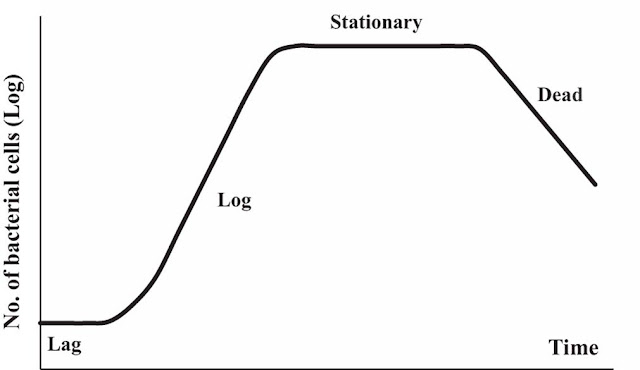Bacterial Growth Curve! Factors Affecting Bacterial Growth.
Content
Bacterial Cell Division
Generation Time
Bacterial count
Bacterial Growth Curve
1. Bacterial Cell Division:-
Bacteria divides by binary fission. Bacterial nucleus or chromosome is a circular double stranded DNA molecule. Bacterial growth is proliferation of bacterium into two doughter cells.
During replication, the two strands of DNA are separated and new complementary strands are form. Thus two identical double stranded DNA molecules are form.
2. Generation Time:-
The time require for a bacterium to give rise to doughter cells under optimum conditions, is known as generation time.
The generation time in most of the medically important bacteria is about 20 minutes. In mycobacterium tuberculosis it is about 20 hours and in lepra bacilli it is about 20 days.
The generation time is most important in the bacterial growth. The time is required basically 20 minutes to 20 days for growth.
3. Bacterial Count:-
- Total count:- Total count is indicate the total number of bacteria in the specimen, irrespective of whether they are living or dead.
- Viable count:- Viable count is the number of bacteria living (viable) cells measures.
4. Bacterial Growth Curve:-
When a bacteria is inoculate into a suitable culture medium and incubated it’s growth follows a definite curve.
When a bacteria count of such culture is determine at different intervals and plotted in relation to time a growth curve is obtain.
The bacterial growth curve has different phases which are as follows-
A. Lag phase
B. Log phase
C. Stationary phase
D. Phase of decline
A. Lag phase:-
After inoculation of the culture medium, multiplication usually doesn’t begin immediately. The period between inoculation and beginning of multiplication is known as lag phase.
During this phase of the bacterial growth cycle, synthesis of RNA, enzymes and other molecules occurs. During this period the organisms adapt to the new environment.
This is increase in the size of the cells but there is no appreciable in increase in the members.
B. Log phase:-
Cell division starts and their members increase exponentially or by geometric progression with time. The actual rate of this growth depends upon the growth conditions.
If the logarithm of the viable count is plotted against time, a straight line is obtain. Exponentially growth can not continue indefinitely, however, because the medium is so depleted of nutrients and enriched with wastes.
C. Stationary phase:-
After log phase, the bacterial growth ceases almost completely due to exhaustion of nutrients and accumulation of toxic products.
The number of viable cells remain stationary as there is almost a balance between the dying cells and the new form cells.
D. Phase of decline:-
After a period of stationary phase the bacterial population decreases due to the death cells.
There is decline in viable count and not in total count.
Read Also.
Environmental factors affecting bacterial growth
1. Moisture:-
Moisture is an essential requirement for the group of bacteria, because 80% of the bacterial cell consist of water.
2. Oxygen:-
On the basis of requirement of oxygen bacteria are divides into aerobes and anaerobes.
I. Aerobes- They require oxygen for their growth.
II. Anaerobes- They are growth only in the absence of oxygen.
3. Carbon dioxide:-
Amal amount of carbon dioxide is required by all bacteria.
4. Temperature:-
The optimum temperature range varies with different bacterial species.
Most of the pathogenic bacteria grow optimally at 37°C (Our body temperature)
5. PH:-
Most of the medically important bacteria can grow at pH 7.2-7.6, some bacteria such as lactobacilli and vibiro cholera grow at acidic and alkaline respectively.
6. Body fluid:-
Body fluid include extracellular and intracellular fluid and electrolytes and blood is necessary for bacterial growth.








Post a Comment